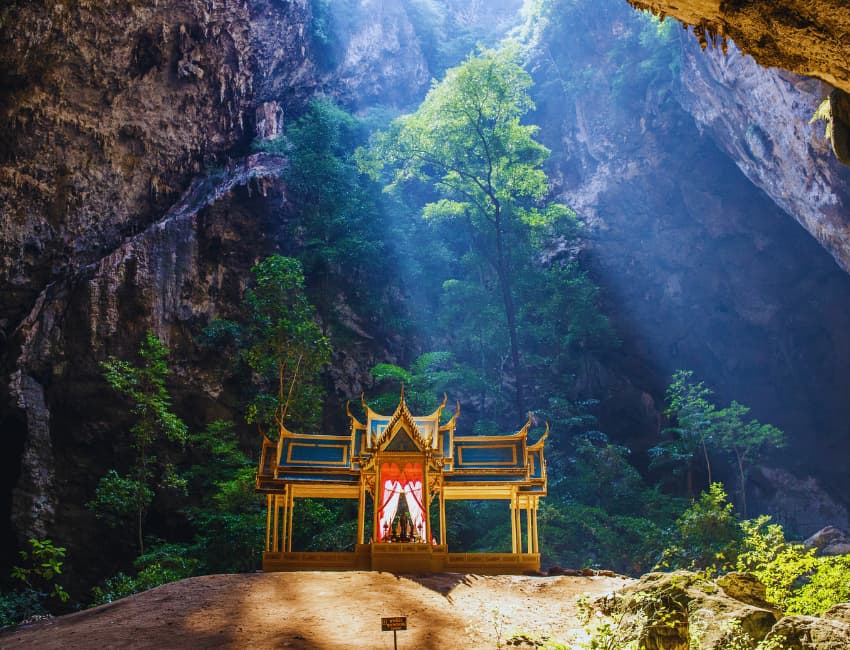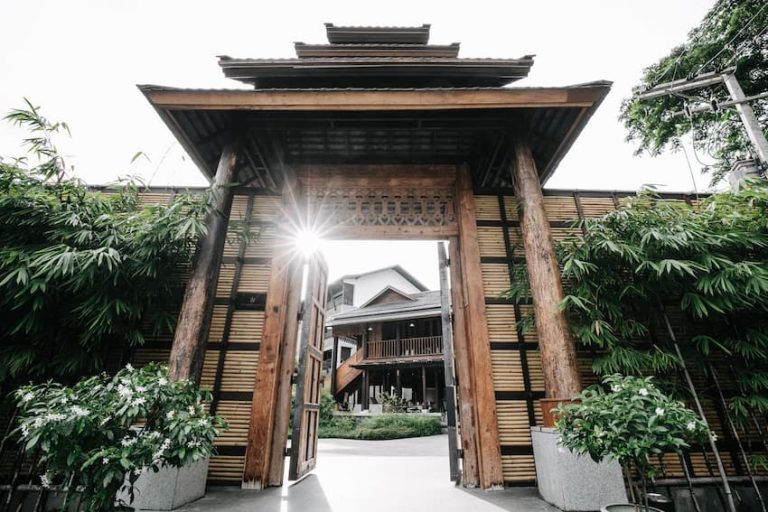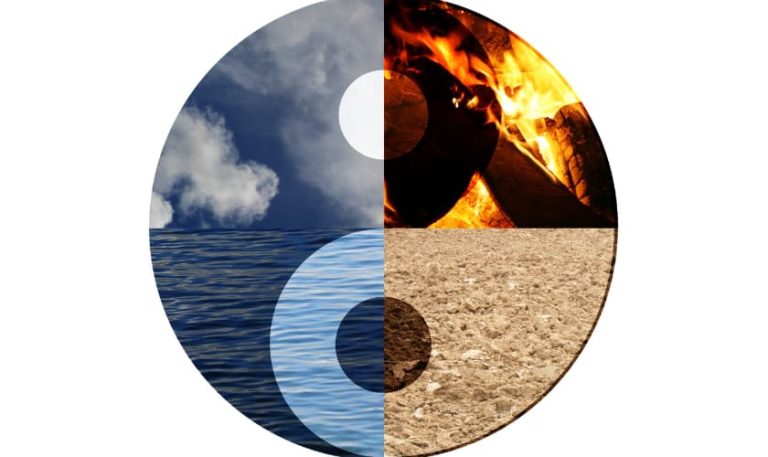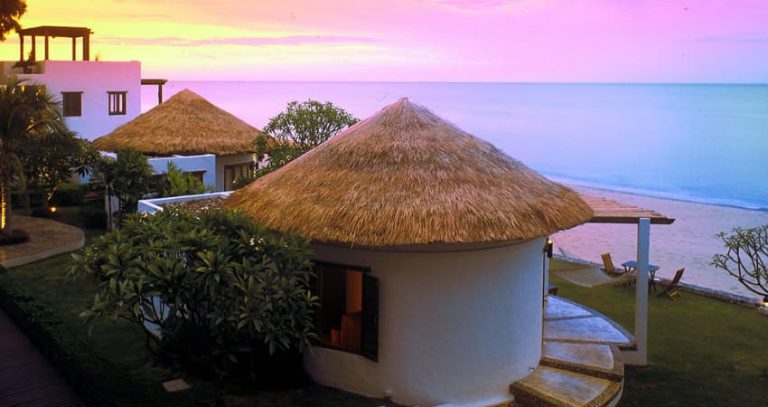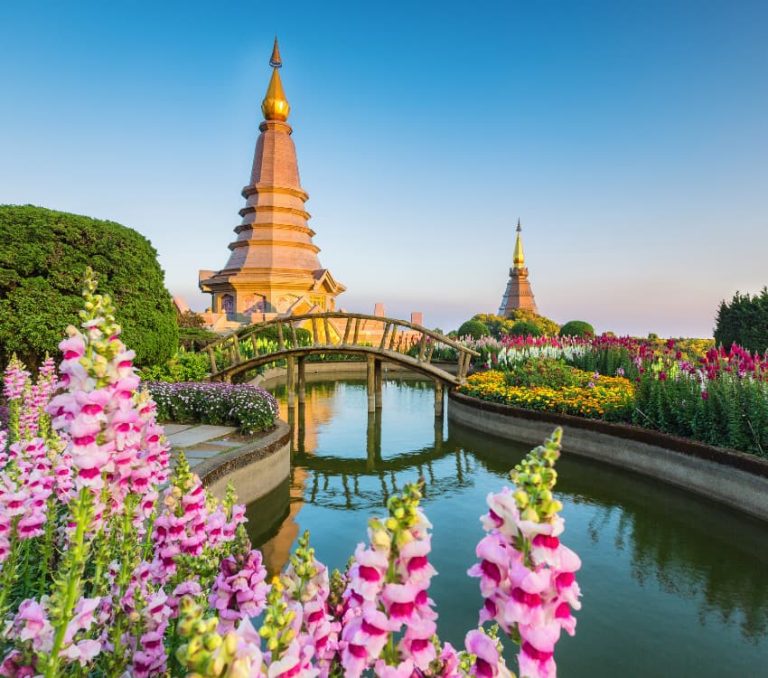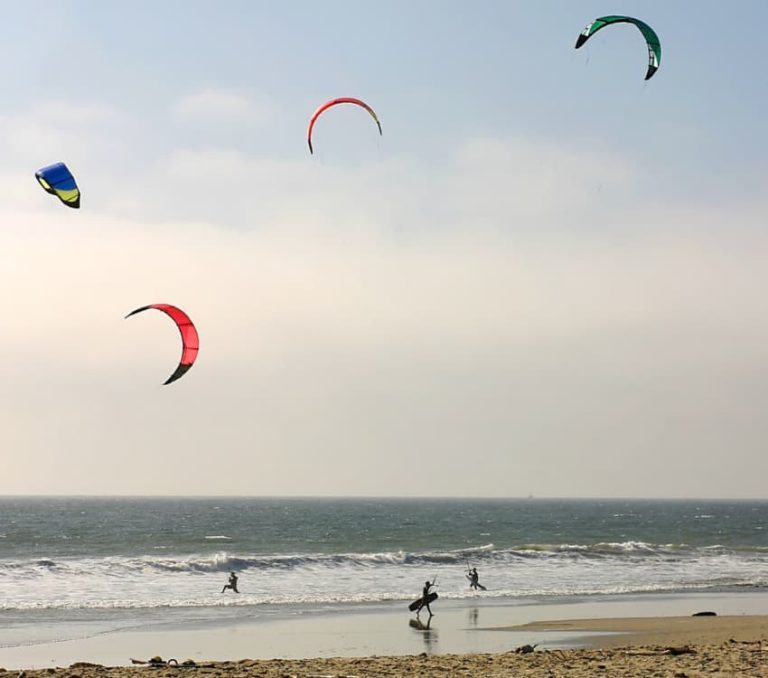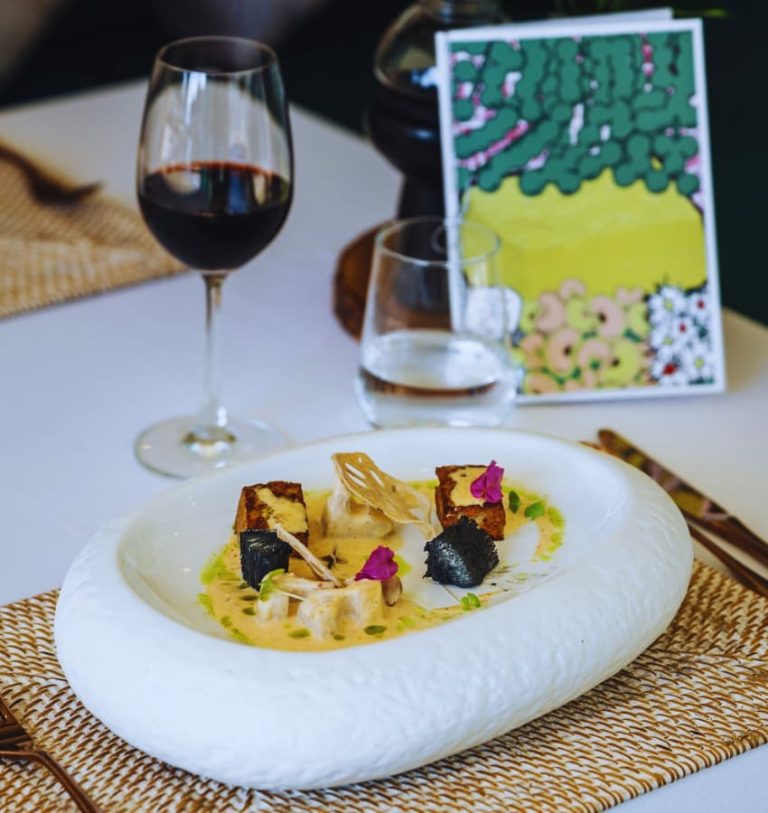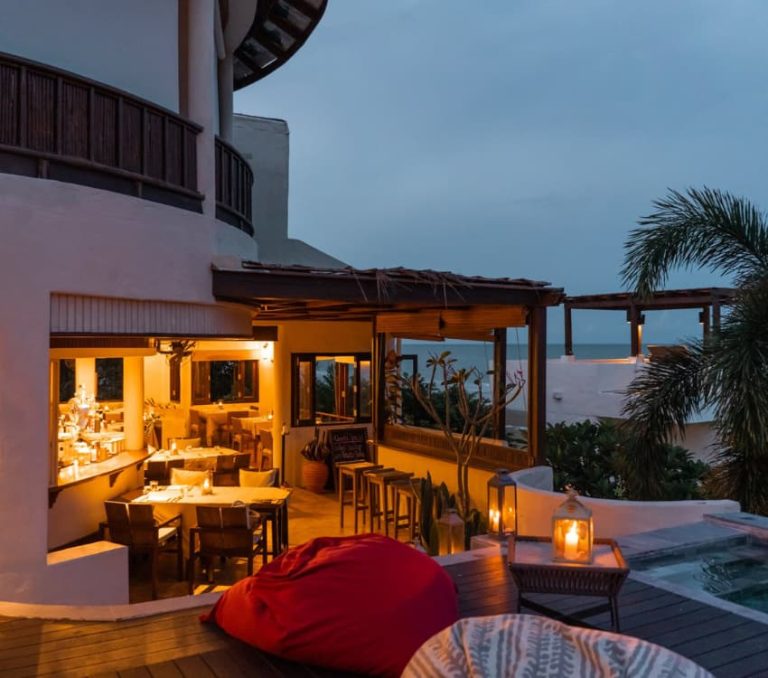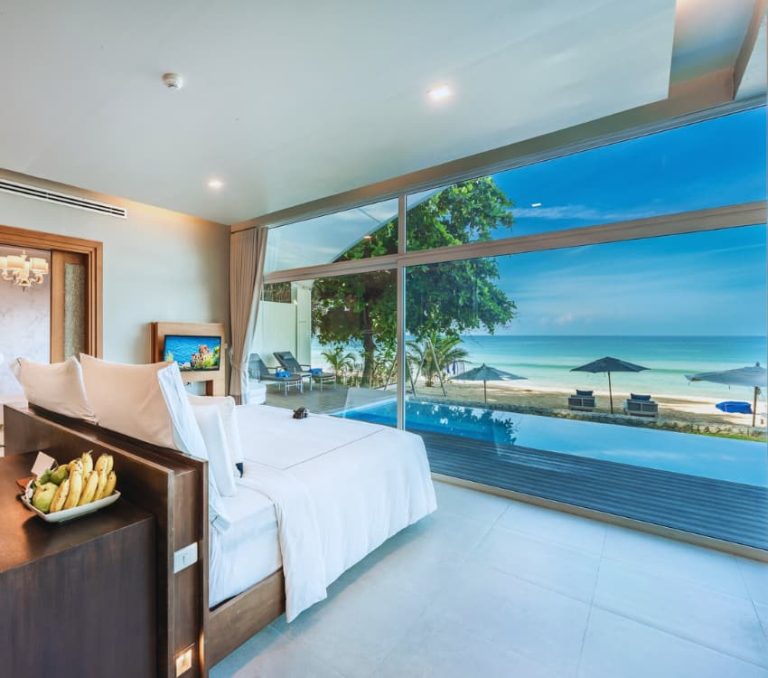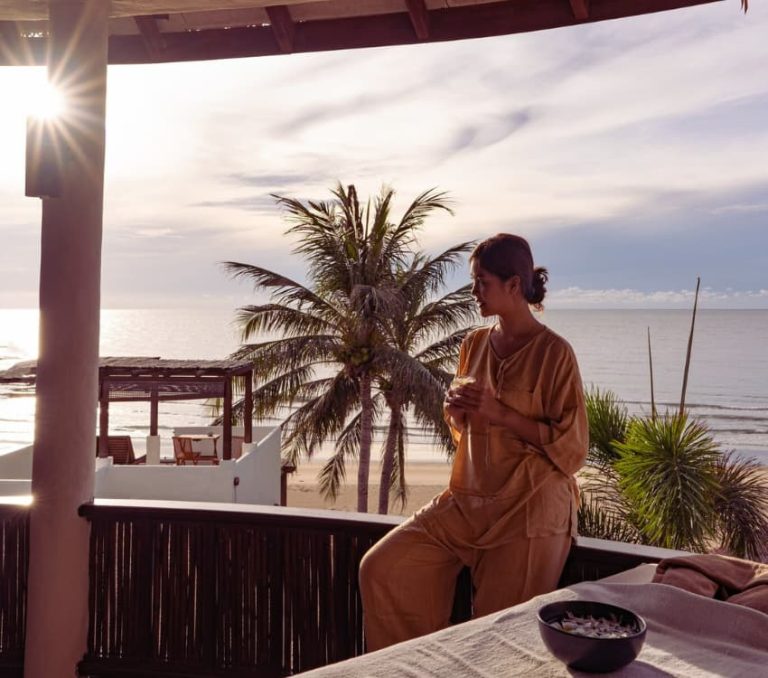Hidden deep within the rugged landscape of Khao Sam Roi Yot National Park, Phraya Nakhon Cave (Hua Hin Cave) is a sight to behold. As sunlight filters through the cave’s ceiling, it illuminates the majestic Kuha Karuhas Pavilion, casting a golden glow that contrasts beautifully with the surrounding darkness. This scene, straight out of a fairy tale, evokes a sense of wonder and mysticism, making it one of the most photographed spots in Thailand. The pavilion’s intricate design and serene setting are a testament to the country’s rich cultural heritage.
Phraya Nakhon Cave is more than just a natural wonder; it is a historical landmark with deep cultural significance. Discovered over 200 years ago by Chao Praya Nakhon Sri Thammarat, the cave has since become a symbol of Prachuap Khiri Khan Province. Its remote location and challenging access route make it a hidden gem, offering a unique experience for those willing to embark. From its enchanting natural beauty to its storied past, Phraya Nakhon Cave is a must-visit destination in Hua Hin, captivating visitors with its mystical atmosphere and historical allure.
Phraya Nakhon Cave
Nestled within the lush expanse of Khao Sam Roi Yot National Park in Prachuap Khiri Khan Province, Phraya Nakhon Cave is a true hidden treasure. This national park, known for its stunning karst landscapes and diverse ecosystems, provides a dramatic backdrop for the cave. Located approximately 45 kilometres south of Hua Hin, the cave is accessible through a challenging hike or a boat ride followed by a trek, adding to its allure and sense of adventure.
The historical significance of Phraya Nakhon Cave adds depth to its natural beauty. The cave was discovered over 200 years ago by Chao Praya Nakhon Sri Thammarat, who stumbled upon it while seeking shelter from a storm. His discovery transformed the cave into a site of cultural and historical importance. The most notable feature within the cave is the Kuha Karuhas Pavilion, built in 1890 to commemorate King Rama V’s visit. This elegant pavilion, illuminated by sunlight streaming through the cave’s ceiling, symbolises Thailand’s royal heritage and natural splendour.
Over the years, several Thai kings have visited Phraya Nakhon Cave, each leaving their mark on its storied walls. The cave’s blend of natural wonder and historical depth makes it a compelling destination for those exploring Thailand’s rich cultural landscape.
Unique Features of Phraya Nakhon Cave
At the heart of Phraya Nakhon Cave lies the Kuha Karuhas Pavilion, a striking symbol of Thailand’s royal heritage. Constructed in 1890 during the reign of King Rama V, this elegant structure was built to honour the king’s visit to the cave. The pavilion’s gold and green hues and its intricate design reflect the grandeur and artistic sensibility of Thai culture. Positioned perfectly to catch the sunlight that streams through the cave’s ceiling, the pavilion is illuminated in a magical glow each morning, creating a sight that is both awe-inspiring and deeply symbolic of the connection between nature and human craftsmanship.
The natural beauty of Phraya Nakhon Cave is equally captivating. The cave consists of two large chambers, each with rooftop openings that allow sunlight to penetrate and illuminate the interior. This natural light contrasts dramatically with the cave’s shadows, enhancing its mystical atmosphere. The first chamber, characterised by its rugged terrain and ancient stalactites and stalagmites, offers a glimpse into the area’s geological history.
As visitors enter the cave, they encounter the second chamber, home to the Kuha Karuhas Pavilion. Here, the sunlight filtering through the ceiling openings creates a breathtaking display, spotlighting the pavilion and casting intricate shadows on the cave walls. Adding to the enchantment is a small forest that has taken root within the cave, nourished by the sunlight. This unique combination of natural light, lush greenery, and the historical pavilion makes Phraya Nakhon Cave a vivid tableau of natural beauty and cultural heritage.
The interplay of light and shadow, the serene forest, and the historic pavilion create a tranquil and majestic setting, offering visitors an unforgettable experience.
Getting to Phraya Nakhon Cave
Reaching Phraya Nakhon Cave is an adventure, starting from the famous seaside resort town of Hua Hin. The journey begins with a scenic 45-minute drive south to the small village of Bang Pu. This drive is a delightful experience, offering picturesque views of beaches, mountains, and forests, setting the tone for the adventure ahead.
Once in Bang Pu, visitors have two main transportation options to reach Laem Sala Beach, the starting point for the final leg of the journey to Phraya Nakhon Cave. The first option is a boat ride around the cape to Laem Sala Beach. This ride costs between 150 and 200 baht per person for a round trip and offers an exciting and breezy way to start the adventure. The boat trip is not just a means of transportation; it also provides opportunities to enjoy the surrounding seascape and possibly visit Monkey Island, a nearby attraction where playful langurs can be observed in their natural habitat.
For those who prefer to stay on land, the second option is a 30-minute hike from Bang Pu over the hill to Laem Sala Beach. This trek involves navigating a well-marked trail with a mix of tracks and stairs, offering several viewing platforms along the way. The hike is moderately challenging but rewarding, providing stunning panoramic views of the coastline and the surrounding natural beauty.
The final leg of the journey to Phraya Nakhon Cave begins from Laem Sala Beach. This involves a challenging 430-meter hike through a forest with uneven and steep steps. The ascent can be demanding, requiring hand ropes in some sections for added stability. The climb typically takes about 30 minutes, but the breathtaking views make it worthwhile. Rest stops offer glimpses of the beach, the sea, and islands, allowing hikers to catch their breath and soak in the scenery.
As hikers approach the top of the hill, the path becomes more manageable, leading into the first chamber of Phraya Nakhon Cave. Despite the effort required, the journey to the cave is a significant part of the experience, providing a sense of accomplishment and anticipation that culminates in the awe-inspiring beauty of the cave itself.
The Hiking Experience
The adventure to Phraya Nakhon Cave begins with a 30-minute hike from Laem Sala Beach. This initial hike takes visitors through a lush, tropical landscape, gradually introducing the natural beauty of Khao Sam Roi Yot National Park. The well-marked trail winds through dense foliage, with the sound of the waves occasionally breaking through the sounds of nature. This part of the journey is relatively easy, allowing hikers to enjoy the scenery and wildlife.
The real challenge starts with the 430-meter ascent to the cave entrance. This climb is characterised by steep, uneven steps that can be physically demanding. The path is rugged; in many places, hikers will find hand ropes installed to assist with the steepest sections. These ropes provide much-needed support, especially for those less experienced hiking on such terrain.
Despite its difficulty, the climb is interspersed with several rest stops strategically placed to offer breathtaking views of the beach, the shimmering sea, and the small islands dotting the horizon. These stops provide an excellent opportunity to catch your breath, hydrate, and enjoy the picturesque surroundings. Seeing the coastline from these vantage points makes the effort feel rewarding and motivates hikers to continue their journey.
As hikers near the top of the hill, the trail becomes more manageable, signalling the approach to the cave. The path begins to descend slightly, leading into the first chamber of Phraya Nakhon Cave. This moment marks the culmination of the challenging hike and the beginning of an awe-inspiring exploration of one of Thailand’s most beautiful natural wonders.
Inside Phraya Nakhon Cave
Stepping into the first chamber of Phraya Nakhon Cave feels like entering another world. Naturally sculpted over centuries, the cavernous space features a striking dry waterfall composed of mineral deposits cascading down the rock face. Stalactites hang from the ceiling like ancient chandeliers, while stalagmites rise from the ground, creating an otherworldly landscape. Sunlight streams through holes in the cave’s roof, casting beams of light that dance across the rocky surfaces. This interplay of light and shadow enhances the mystical feel, making the first chamber a captivating introduction to the cave’s wonders.
Venturing deeper into the cave, visitors arrive at the second chamber, where the highlight of Phraya Nakhon Cave awaits: the Kuha Karuhas Pavilion. This royal pavilion, built in 1890 to commemorate King Rama V’s visit, stands majestically at the chamber’s centre. The pavilion’s gold and green hues and its intricate architectural details create a stunning visual contrast against the cave’s rugged interior.
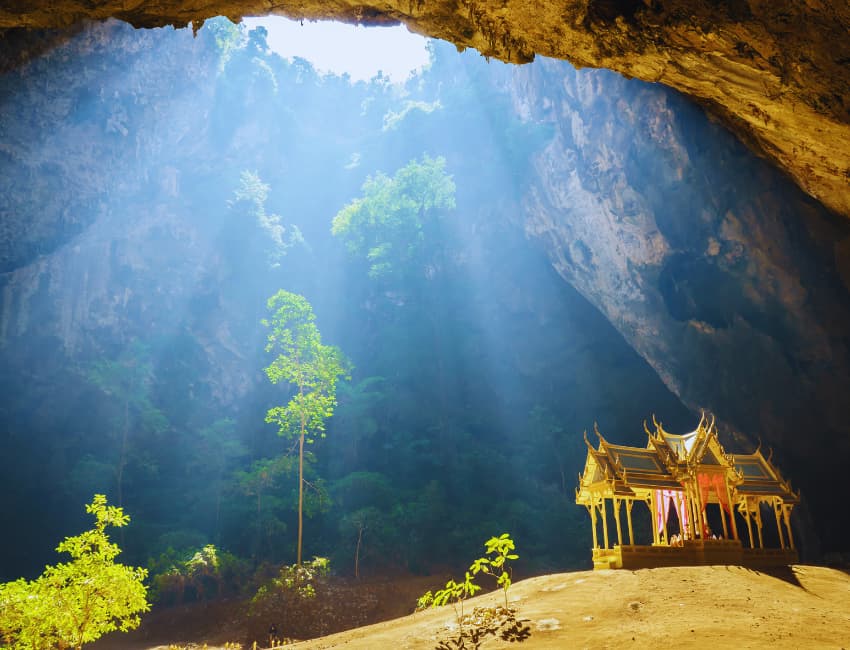
Sunlight filters through a large opening in the ceiling, perfectly illuminating the pavilion and creating a breathtaking sight that feels almost ethereal. This natural spotlight highlights the pavilion’s beauty and the harmony between nature and human craftsmanship.
Surrounding the pavilion are the historical inscriptions left by visiting Thai kings, including King Rama V and King Rama VII. These inscriptions add a profound sense of history and reverence to the chamber, connecting visitors to the cave’s royal heritage.
The second chamber’s serene atmosphere is enhanced by the presence of a small forest nurtured by the sunlight streaming through the roof. Trees and vegetation thrive within this unique environment, adding a touch of green to the rocky landscape. The tranquillity of this chamber, combined with the awe-inspiring sight of the Kuha Karuhas Pavilion, creates a space that is both peaceful and majestic, offering visitors a moment of reflection and wonder.
Practical Tips for Visitors
To fully appreciate the beauty of Phraya Nakhon Cave, it is best to visit in the early morning. During this time, the sunlight streams through the cave’s openings, illuminating the Kuha Karuhas Pavilion in a stunning natural light display. This magical effect not only enhances the pavilion’s splendour but also provides excellent opportunities for photography. Arriving early also helps avoid the midday heat and the crowds, ensuring a more pleasant and serene experience.
When preparing for your visit, it is essential to bring the right gear. Sturdy shoes are a must, as the hike involves steep and uneven terrain that can be challenging without proper footwear. Carrying enough water is crucial to stay hydrated during the trek, especially given the humid climate and the physical exertion required. Sunscreen and a hat will protect you from the sun’s rays, particularly during the exposed portions of the hike. Insect repellent is also recommended to guard against bites while navigating forested areas.
Facilities at Laem Sala Beach and within Khao Sam Roi Yot National Park are designed to enhance your visit. At Laem Sala Beach, you will find basic amenities such as restrooms and small restaurants where you can grab a refreshing drink or a snack before or after your hike. These spots also offer a chance to relax and enjoy the scenic coastal views. Within the national park, various information boards and guides are available to help you navigate the trails and learn more about the area’s natural and historical significance.
Khao Sam Roi Yot National Park
Beyond the captivating Phraya Nakhon Cave, Khao Sam Roi Yot National Park offers a wealth of other attractions that showcase the area’s natural beauty and biodiversity. One such highlight is the Bueng Bua Nature Observation Center. This scenic boardwalk winds through the park’s freshwater marsh, providing an excellent opportunity to observe various bird species and aquatic plants. The tranquil setting and the panoramic views of the surrounding limestone mountains make it a perfect spot for nature enthusiasts and photographers.
For those who enjoy hiking, the park boasts several trails catering to different difficulty levels and interests. For example, the Khao Daeng Viewpoint trail offers a moderately challenging hike that rewards visitors with breathtaking views of the coastline and the park’s rugged terrain. Another popular option is the trail to Sai Cave, which features impressive stalactites and stalagmites similar to those found in Phraya Nakhon Cave but in a more secluded setting.
Khao Sam Roi Yot National Park offers a range of accommodation options to suit different preferences and budgets. The park offers bungalows that provide comfort and convenience near the main attractions for a family-friendly stay. These bungalows are ideal for those looking to immerse themselves in nature while enjoying the comforts of home.
Camping is another popular choice for visitors who want to experience the park’s natural surroundings fully. The park has designated camping areas where visitors can pitch a tent and enjoy a night under the stars. Camping allows for a deeper connection with nature and gives visitors the flexibility to explore the park at their own pace.
For those wanting a more luxurious retreat, nearby boutique resorts such as Aleenta Hua Hin Resort & Spa offer an exquisite blend of comfort and elegance. Located a short drive from the national park, Aleenta provides a serene beachfront setting with world-class amenities, including private villas, wellness programs, and gourmet dining options. Staying at Aleenta Hua Hin allows visitors to enjoy the natural beauty of Khao Sam Roi Yot National Park during the day while retreating to a luxurious sanctuary at night.
FAQs
Q: How do I get to Phraya Nakhon Cave?
To reach Phraya Nakhon Cave, travel to Khao Sam Roi Yot National Park in Prachuap Khiri Khan Province. From Hua Hin, it’s a 45-minute drive south to Bang Pu village. You can take a boat to Laem Sala Beach or hike over a hill. From Laem Sala Beach, a 430-meter hike leads to the cave entrance.
Q: What is the entrance fee to the cave?
The entrance fee for Khao Sam Roi Yot National Park is 200 baht for foreign adults and 100 baht for foreign children. Thai adults pay 40 baht, and Thai children pay 20 baht. There is no additional admission fee for the cave itself.
Q: What is the best time to visit the cave?
The best time to visit Phraya Nakhon Cave is between 10 AM and 11 AM. During this time, sunlight streams through the cave’s openings, illuminating the Kuha Karuhas Pavilion and creating a stunning visual effect.
Q: Is the hike to the cave challenging?
The hike to Phraya Nakhon Cave is moderately challenging. The initial 30-minute hike from Laem Sala Beach is relatively easy, but the final 430-meter climb to the cave entrance involves steep and uneven steps, requiring hand ropes for assistance in some sections.
Q: Are there guided tours available?
Guided tours can be arranged through local tour agencies or at Hua Hin. A guide can provide valuable insights into the cave’s history, geology, and the surrounding national park.
Q: Are there food and restroom facilities available?
Basic food and restroom facilities are available at Laem Sala Beach. However, as there are no facilities within the cave itself, it’s a good idea to bring snacks and water for the hike.
Q: Is photography allowed inside the cave?
Yes, photography is allowed inside Phraya Nakhon Cave. Visitors are encouraged to capture the stunning beauty of the cave and the pavilion. However, avoiding flash photography is advisable to preserve the natural ambience.
Q: Can I swim in the cave?
There is no body of water inside Phraya Nakhon Cave suitable for swimming. However, you can swim at Laem Sala Beach before or after visiting the cave.
Q: Is the cave open all year round?
Phraya Nakhon Cave is generally open all year round. However, to avoid heavy rain and slippery hiking conditions, visit during the dry season, from November to April. Always check local weather forecasts and park announcements before planning your trip.
Related Articles:
- Pranburi Beach
- Khao Sam Roi Yot National Park in Hua Hin
- Hua Hin Travel Guide
- Temples in Hua Hin
- The Best Beaches in Hua Hin
Aleenta Hua Hin
Pranburi Resort & Spa
Pranburi Resort & Spa

